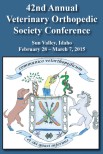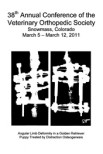Objective: To quantify how increasing axial loads combined with different femoral fixation methods impact simulated quadriceps and gastrocnemius muscle forces.
Study design: Experimental, non-randomized, ex vivo study.
Methods: A custom limb press permitting axial loads of 10%-40% bodyweight with three femoral fixation models was tested with 24 limbs from 12 cats (4 per method). Fixation models were: one-complete hip mobility, two-rigid femoral fixation, three-flexion-extension hip mobility. Femoral angulation to horizontal of 60° ±5° and stifle/hock angulations of 120° ±5° were maintained using turnbuckles. Primary outcomes were bodyweight normalized quadriceps and gastrocnemius forces, and their ratio. Secondary outcomes were radiographic limb angulation and relative foot position for models 2 and 3.
Results: Normalized quadriceps forces increased more with axial load in models 1 and 3 than model 2 (p = .04), whereas normalized gastrocnemius force increased more with model 2 than models 1 and 3 (p = .009). Force ratios were unaffected by axial load (p = .4), but model 2 ratios were lower than models 1 and 3 (p = .007). Femoral angulation did not differ with load (p = .1) or model (p = .9), but both stifle and hock flexed with increasing load (p < .001) but remained largely within target. Relative foot position was mean 3.9 mm more caudal in model 2 than model 3.
Conclusion: Simulated muscle forces were proportionate to axial load, while rigid femoral fixation negatively affected both forces and ratios.
Clinical significance: Retaining hip flexion-extension yields normalized quadriceps forces closer to in vivo values and could improve current ex vivo models.









